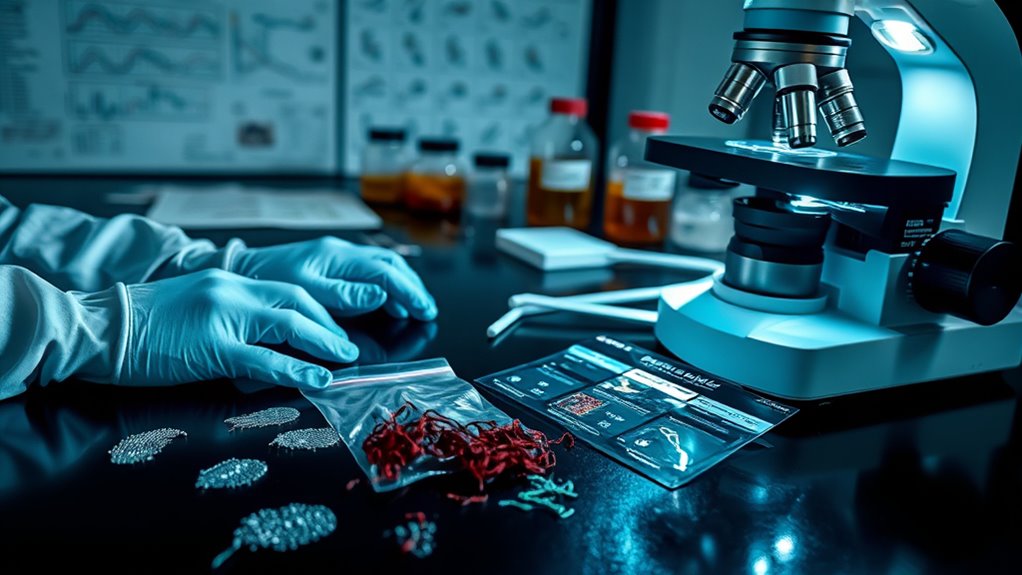After collecting evidence at the scene, you carefully preserve and document each item to maintain its integrity, ensuring proper chain of custody. You then analyze the evidence using forensic techniques like fingerprinting, ballistics, and digital forensics, all while preventing contamination. Witness statements are evaluated for reliability and cross-checked with physical evidence. Finally, you compile your findings into a clear report, building a strong case—if you keep exploring, you’ll discover how each step contributes to solving the crime.
Key Takeaways
- Investigators carefully collect and preserve evidence, ensuring a strict chain of custody to maintain integrity.
- Forensic analysis employs imaging, chemical tests, and specialized tools to examine evidence comprehensively.
- Digital forensics involves acquiring and securing electronic data, verifying authenticity through hash checks and encryption methods.
- Witness statements are evaluated for credibility, consistency, and potential bias, then integrated with physical evidence.
- Scene reconstruction and ballistic testing help establish crime dynamics, shooter positions, and link evidence to suspects.
Gathering and Preserving Evidence
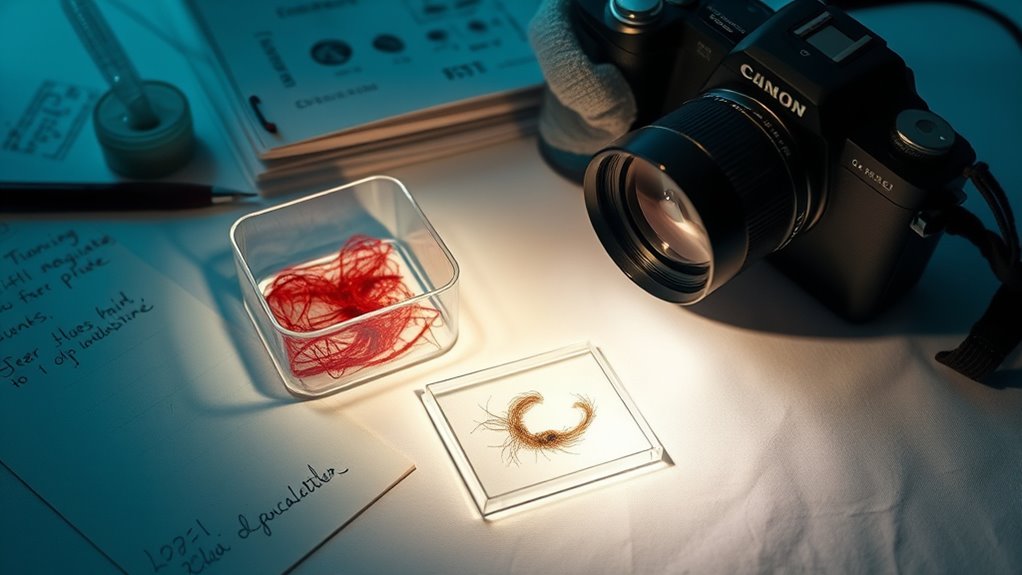
When gathering and preserving evidence, it’s vital to handle each item carefully to maintain its integrity. You must establish a clear chain of custody, ensuring every transfer or movement is documented precisely. Proper evidence packaging is essential; use the right containers to prevent contamination or damage. Seal evidence securely and label it accurately with details such as date, time, location, and collector’s name. Avoid shortcuts—improper packaging or mishandling can compromise the evidence’s value in court. Always follow established protocols to prevent tampering or loss. Consistent documentation and adherence to procedures further protect the evidence from potential challenges in court. By maintaining a strict chain of custody and using proper evidence packaging, you preserve the evidence’s credibility. Your careful handling safeguards the integrity of the investigation and ensures that the evidence remains admissible throughout the legal process. Incorporating proper evidence handling techniques can also help in preventing accidental contamination or loss, which is especially important given the increasing sophistication of cybersecurity threats that can compromise digital evidence. Additionally, understanding the horsepower of electric dirt bikes can be relevant when analyzing evidence related to vehicle performance or modifications in certain investigations. A thorough knowledge of evidence preservation protocols ensures that investigators are prepared to address any challenges that might arise during the legal process.
Forensic Analysis Techniques
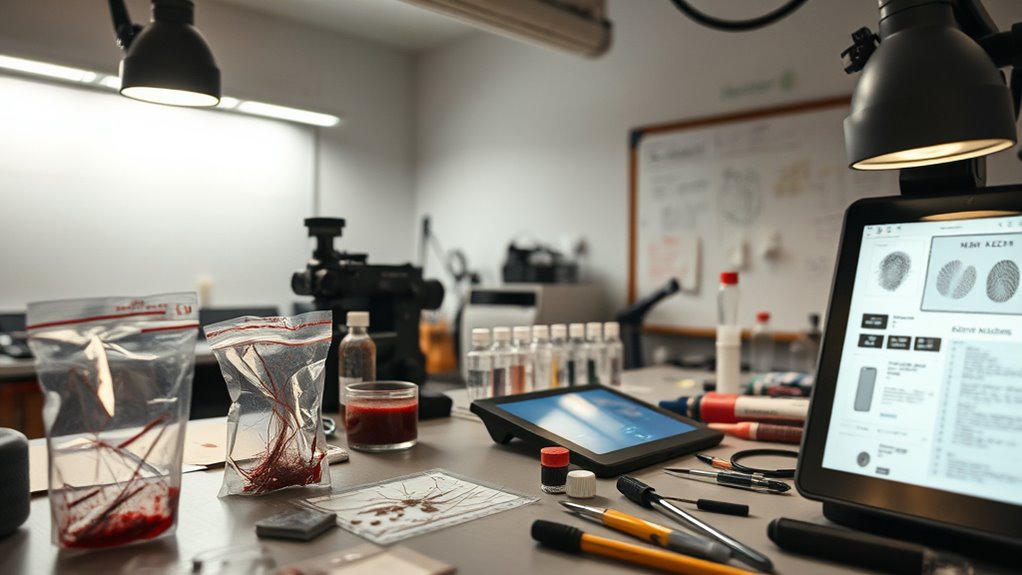
After securing and documenting evidence, analyzing it accurately becomes the next vital step in the investigative process. Forensic analysis techniques utilize innovative imaging methods to reveal details invisible to the naked eye, such as subtle markings or alterations. Trace chemical analysis helps identify substances like drugs, toxins, or residues, providing critical clues. These methods often work together to build a thorough picture of the crime scene. Understanding the resources and tools available can enhance the effectiveness of forensic investigations.
DNA and Fingerprint Examination
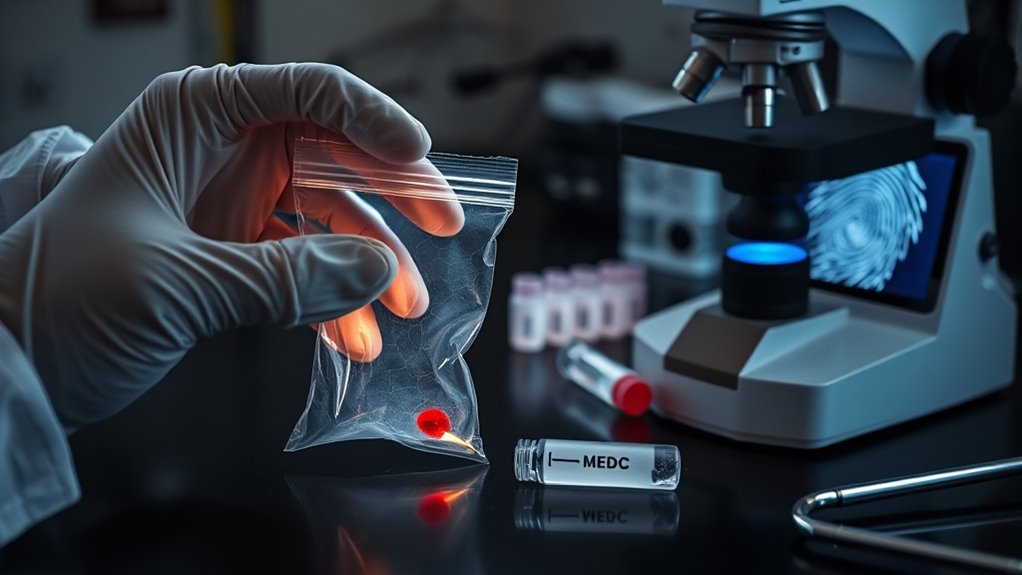
DNA and fingerprint examination are essential forensic techniques that help identify suspects and link them to crime scenes. To guarantee accurate results, you must maintain a strict chain of custody, tracking evidence at every step. Contamination prevention is critical; you should wear gloves, use sterile tools, and store samples properly. When analyzing evidence, keep these points in mind:
- Properly label and secure all evidence to avoid mix-ups.
- Use controlled environments to prevent contamination.
- Document each transfer to preserve the integrity of the chain of custody.
- Regularly review forensic procedures to ensure adherence to best practices.
- Employ professional equipment to enhance the quality and reliability of analysis. Additionally, staying updated on vetted forensic methods ensures the use of current and validated techniques in evidence analysis.
- Implement standardized protocols to maintain consistency across investigations.
Furthermore, understanding the causes and contributing factors of errors in forensic analysis can help in developing more robust procedures and minimizing mistakes.
Ballistics and Firearm Analysis

Have you ever wondered how investigators match a bullet to a specific firearm? It’s through ballistics testing, where they analyze the markings left on bullets and cartridge cases. Every firearm leaves unique ridges and impressions—like a fingerprint—that can be identified under a microscope. Firearm trajectory also plays an essential role; by examining the bullet’s path, investigators determine the shooter’s position and the weapon’s angle. They compare test-fired bullets from suspect guns to evidence bullets to establish a match. This process helps reconstruct shooting scenes and confirms firearm involvement. With precise analysis of ballistic evidence, investigators piece together how a crime happened, providing vital insights that link a weapon to a particular crime scene or victim. Ballistic analysis techniques are continually evolving with advancements in technology, enhancing the accuracy and reliability of forensic investigations.
Digital Forensics and Cyber Evidence
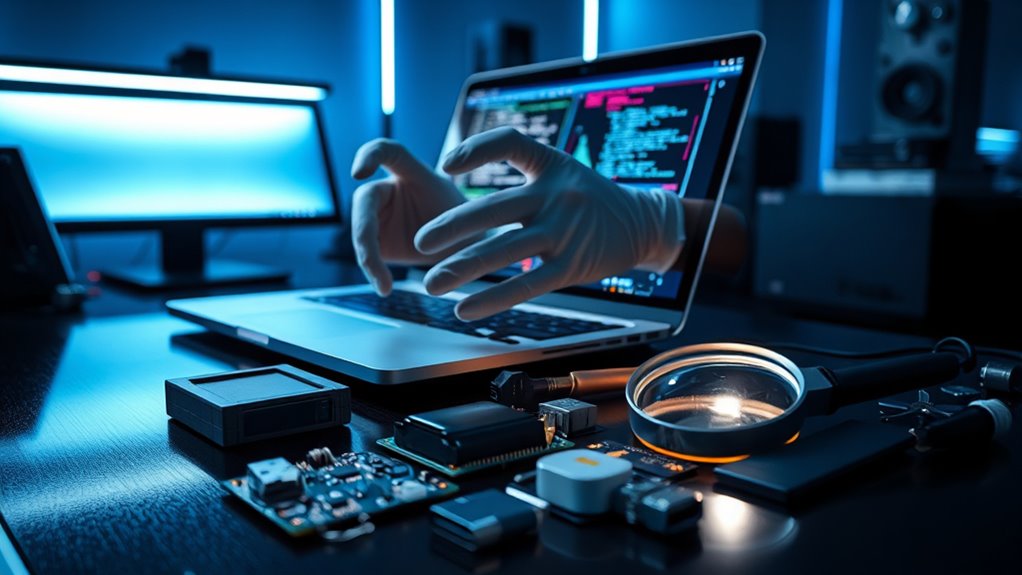
When handling digital evidence, you need effective acquisition techniques that preserve data integrity and prevent contamination. Cybersecurity measures are essential to protect the evidence from tampering or unauthorized access. Ensuring data integrity throughout the investigation is critical to maintaining the credibility of your findings. Utilizing accurate calibration of forensic tools helps ensure that the collected data remains trustworthy and unaltered. Additionally, staying informed about emerging automation technologies can enhance the efficiency and accuracy of digital forensic processes. Incorporating proper training in these technologies is also vital for investigators to adapt to evolving digital landscapes. Regularly reviewing newborn care guidelines can help ensure that digital forensic practices remain aligned with the latest standards and safety protocols.
Digital Evidence Acquisition Techniques
Digital evidence acquisition techniques are essential tools in modern investigations, enabling forensic experts to collect and preserve electronic data without altering its integrity. You need to understand key methods such as:
- Using specialized software to image devices, ensuring an exact copy of data.
- Employing encryption methods to decrypt protected information without tampering.
- Accessing cloud storage services to retrieve data stored remotely while maintaining chain of custody.
These techniques help you navigate encrypted files and cloud environments securely. You must verify the integrity of the evidence at every step, avoiding modifications that could compromise the case. Proper acquisition ensures that digital evidence remains admissible in court and preserves its evidentiary value.
Cybersecurity and Data Integrity
Ensuring data integrity is essential in cybersecurity and digital forensics, as the credibility of evidence depends on it. You must verify that digital evidence remains unaltered during collection and analysis. To do this, you’ll implement strict protocols, including hash checks and secure storage. Recognizing threats like phishing scams helps you identify compromised systems, while malware detection tools reveal malicious software that could tamper with data. By maintaining rigorous security measures, you prevent evidence contamination and guarantee its reliability in court. Your focus on cybersecurity safeguards the chain of custody, preserving the integrity of cyber evidence. Ultimately, your diligence in verifying data integrity strengthens the overall investigation and supports the pursuit of justice.
Witness Statements and Testimony Evaluation
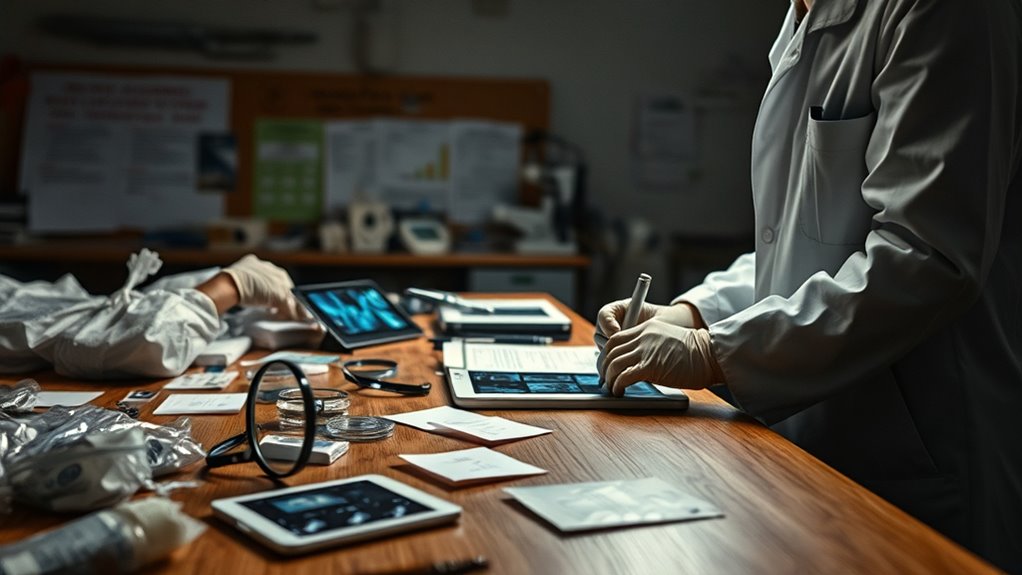
How do investigators determine the reliability of witness statements and testimonies? You need to evaluate testimonial credibility by considering factors like eyewitness bias, memory accuracy, and consistency. First, assess if the witness’s account aligns with physical evidence and other testimonies. Second, identify any signs of eyewitness bias that might color their perception or recollection. Third, review the witness’s history and relationships that could influence their testimony. By doing so, you can filter out unreliable statements and focus on credible evidence. Remember, a witness’s perception can be skewed by stress or suggestion, so critical analysis is essential. This approach helps ensure that your case builds on solid, trustworthy testimony rather than flawed recollections influenced by bias.
Data Integration and Case Correlation
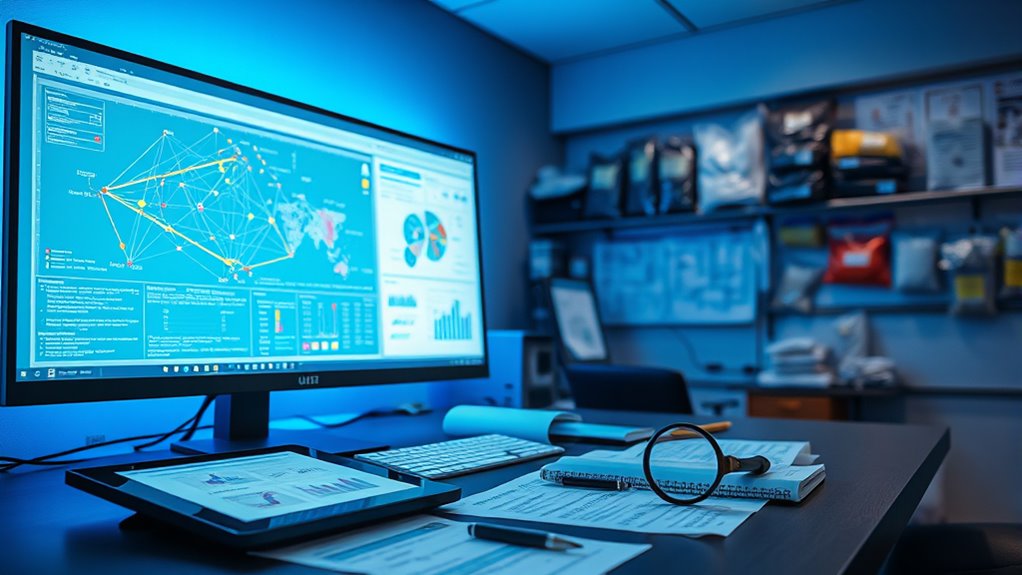
Integrating data from multiple sources is essential for building a thorough case, as it allows you to identify connections and patterns that might otherwise go unnoticed. Data integration combines information from crime scene reports, digital evidence, surveillance footage, and witness statements, creating a complete view of the investigation. Case correlation involves analyzing this integrated data to link related pieces of evidence, revealing relationships between suspects, locations, and events. By effectively performing data integration, you can spot patterns that point to a suspect or uncover motives. Case correlation helps you prioritize leads and focus investigations. Together, these techniques enable you to construct a clear, cohesive narrative, making it easier to present strong, evidence-based conclusions.
Reporting Findings and Building a Case

As an investigator, you need to document your evidence carefully to guarantee nothing is overlooked. Effective correlation of your findings helps build a strong, coherent case. Clear, well-organized reports are essential for presenting your evidence convincingly and supporting your conclusions.
Documenting Evidence Thoroughly
Thorough documentation of evidence is essential for accurately reporting findings and building a solid case. Proper documentation guarantees the integrity and credibility of your investigation. Focus on three key points:
- Maintain an unbroken chain of custody to prove evidence hasn’t been tampered with.
- Use consistent evidence tagging to identify items clearly and prevent mix-ups.
- Record every handling step, including collection, transport, and storage, with detailed notes.
Correlating Findings Effectively
To effectively correlate your findings, you need to connect all pieces of evidence in a logical and coherent manner. Start by analyzing behavior patterns observed during the investigation, noting consistent actions or anomalies that point toward suspect profiling. Recognize how these patterns align with physical evidence, witness statements, and digital footprints. By identifying behavioral trends, you can establish connections between different evidence sets, strengthening your case. Linking evidence through suspect profiling allows you to build a narrative that explains motives, methods, and opportunities. This exhaustive approach ensures your findings are integrated, making it easier to present a clear, compelling story. Ultimately, correlating findings this way enhances your ability to demonstrate how each piece fits into the bigger picture of the investigation.
Presenting Clear Reports
Presenting clear reports is essential for effectively communicating your findings and building a strong case. To do this, focus on proper report formatting, ensuring your document is organized and easy to follow. Highlight key evidence, such as the chain of custody, to establish its integrity and credibility. Remember these three steps:
- Clearly outline your methodology and findings.
- Maintain a logical structure with headings and subheadings.
- Include detailed documentation of evidence handling, emphasizing the chain of custody.
Frequently Asked Questions
How Do Investigators Prioritize Evidence Collection in Complex Cases?
When prioritizing evidence collection in complex cases, you start by establishing an evidence hierarchy, focusing on the most crucial items like DNA or fingerprints. You guarantee the chain of custody is maintained to preserve evidence integrity. You gather and document key evidence first, then proceed to less critical items, all while recording every transfer. This systematic approach helps you build a solid case and prevents contamination or loss of vital evidence.
What Are the Common Challenges Faced During Forensic Analysis?
Did you know that over 60% of forensic analyses face challenges due to degraded evidence? When you tackle forensic analysis, maintaining a strict chain of custody is crucial to prevent contamination. You often encounter issues with fragile forensic artifacts that can be easily compromised. These challenges require meticulous handling and advanced techniques to guarantee evidence integrity, making your work essential for accurate case resolution and justice.
How Is Contamination Prevented During Evidence Handling?
To prevent contamination and maintain evidence integrity, you should always wear gloves, masks, and protective clothing when handling evidence. Use sterile tools and avoid touching evidence directly. Change gloves between samples, and store evidence in proper containers, sealing them securely. Keep evidence away from environmental contaminants, and document each step carefully. These practices help guarantee contamination prevention and preserve the evidence’s integrity for accurate analysis.
What Role Does Technology Play in Modern Forensic Investigations?
Ever wonder how technology transforms forensic investigations? You use digital forensics to recover and analyze electronic evidence, revealing vital details. Advanced tools also assist in crime scene reconstruction, helping you visualize events accurately. These technologies speed up evidence processing, increase accuracy, and uncover hidden clues that manual methods might miss. Isn’t it amazing how modern tech makes solving crimes faster and more precise, ultimately bringing justice closer?
How Do Investigators Ensure the Reliability of Witness Testimonies?
You guarantee the reliability of witness testimonies by evaluating witness credibility and memory accuracy. Investigators carefully interview witnesses, asking clarifying questions to gauge consistency over time. They also look for signs of suggestibility or bias that might affect their accounts. Using techniques like cognitive interviews helps improve memory recall. By cross-referencing testimonies with physical evidence, you can identify discrepancies and build a more accurate, trustworthy case.
Conclusion
You might think all this evidence analysis is overwhelming, but it’s what turns investigations into convictions. By meticulously gathering, preserving, and analyzing each piece, you guarantee no detail is overlooked. Don’t underestimate the power of thorough forensic work—it’s your best chance to uncover the truth and deliver justice. Trust the process; with the right evidence, you can confidently solve even the most complex cases.
